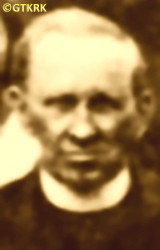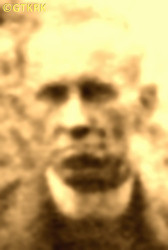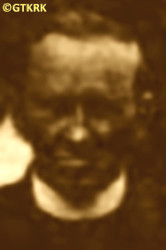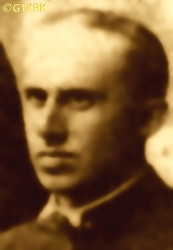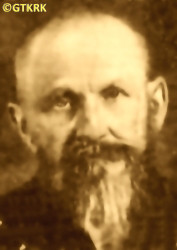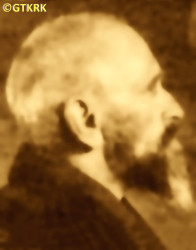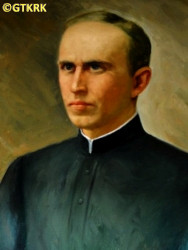Roman Catholic
St Sigismund parish
05-507 Słomczyn
85 Wiślana Str.
Konstancin deanery
Warsaw archdiocese, Poland
full list:
displayClick to display full list

searchClick to search full list by categories
wyświetlKliknij by wyświetlić pełną listę po polsku

szukajKliknij by przeszukać listę wg kategorii po polsku

Martyrology of the clergy — Poland
XX century (1914 – 1989)
personal data
surname
BANDERA
forename(s)
Andrew (pl. Andrzej)
forename(s)
versions/aliases
Andriey (pl. Andrij)

function
eparchial priest
creed
Ukrainian Greek Catholic GCmore on
en.wikipedia.org
[access: 2013.05.19]
diocese / province
Lviv GC archeparchymore on
en.wikipedia.org
[access: 2013.05.19]
nationality
Ukrainian
date and place
of death
10.07.1941

Kievtoday: Kiev city rai., Kiev city obl., Ukraine
more on
en.wikipedia.org
[access: 2023.03.02]
alt. dates and places
of death
08.07.1941
details of death
Ukrainian nationalist activist.
In 10‐11.1918 when Austro–Hungarian Empire was falling one of the organiser of so‐called Ukrainian authorities in Kalus county (f. Stanislaviv voivedship).
In 1919 delegate to the Ukrainian National Council, that announced emergence of Western Ukraine People's Republic ZUNR, from Stanislaviv county.
Volunteer during Polish–Ukrainian war (1919‐1920) — chaplain of 9th Regiment 3rd Berezhany Infantry Brigade of 2nd Corps of Ukrainian Galician Army AUG.
After Ukrainian defeat in hiding from Polish authorities.
After German and Russian invasion of Poland in 09.1939 and start of the World War II, after start of Russian occupation, arrested by the Russian genocidal NKVD on 23.05.1941.
Jailed in Stanislaviv prison and from there transferred to Kiev prison.
Repeatedly tortured.
There, after German attack on 22.06.1941 of their erstwhile ally, Russian, during Russian panic retreat to the east, sentenced by Russians to death and executed.
cause of death
murder
perpetrators
Russians
sites and events
StanislavivClick to display the description, Ribbentrop‐MolotovClick to display the description, Pius XI's encyclicalsClick to display the description
date and place
of birth
11.12.1882

Stryitoday: Stryi urban hrom., Stryi rai., Lviv obl., Ukraine
more on
en.wikipedia.org
[access: 2020.12.03]
presbyter (holy orders)
ordination
1906

positions held
1936 – 1941
parish priest — Trostyanetstoday: Dolyna urban hrom., Kalush rai., Stanislaviv/Ivano‐Frankivsk obl., Ukraine
more on
uk.wikipedia.org
[access: 2023.03.02] ⋄ St Nicholas the Wonderworker GC parish ⋄ Dolynatoday: Dolyna urban hrom., Kalush rai., Stanislaviv/Ivano‐Frankivsk obl., Ukraine
more on
en.wikipedia.org
[access: 2020.11.20] GC deanery
c. 1933 – 1936
parish priest — Volya‐Zaderevatskatoday: Morshyn urban hrom., Stryi rai., Lviv obl., Ukraine
more on
uk.wikipedia.org
[access: 2022.08.05] ⋄ St Michael the Archangel GC parish ⋄ Bolekhivtoday: Bolekhiv urban hrom., Kalush rai., Stanislaviv/Ivano‐Frankivsk obl., Ukraine
more on
en.wikipedia.org
[access: 2020.10.13] GC deanery
1920 – c. 1933
resident — Staryi Uhrynivtoday: Novytsya hrom., Kalush rai., Stanislaviv/Ivano‐Frankivsk obl., Ukraine
more on
en.wikipedia.org
[access: 2022.12.16] ⋄ Presentation of the Lord GC church ⋄ Berezhnytsya shlakhetskatoday: Berezhnytsya, Pidmykhailya hrom., Kalush rai., Stanislaviv/Ivano‐Frankivsk obl., Ukraine
more on
uk.wikipedia.org
[access: 2023.11.24], St Nicholas the Wonderworker and St Euphemia GC parish ⋄ Kalushtoday: Kalush urban hrom., Kalush rai., Stanislaviv/Ivano‐Frankivsk obl., Ukraine
more on
en.wikipedia.org
[access: 2020.11.20] GC deanery
1920 – c. 1933
parish priest — Berezhnytsya shlakhetskatoday: Berezhnytsya, Pidmykhailya hrom., Kalush rai., Stanislaviv/Ivano‐Frankivsk obl., Ukraine
more on
uk.wikipedia.org
[access: 2023.11.24] ⋄ St Nicholas the Wonderworker and St Euphemia GC parish ⋄ Kalushtoday: Kalush urban hrom., Kalush rai., Stanislaviv/Ivano‐Frankivsk obl., Ukraine
more on
en.wikipedia.org
[access: 2020.11.20] GC deanery
1919 – 1920
administrator — Yahilnytsiatoday: Nahirianka hrom., Chortkiv rai., Ternopil obl., Ukraine
more on
en.wikipedia.org
[access: 2023.03.02] ⋄ Our Lord's Resurrection GC parish ⋄ Chortkivtoday: Chortkiv urban hrom., Chortkiv rai., Ternopil obl., Ukraine
more on
en.wikipedia.org
[access: 2020.11.20] GC deanery
1919
parish priest — Buchachtoday: Buchach urban hrom., Chortkiv rai., Ternopil obl., Ukraine
more on
en.wikipedia.org
[access: 2020.11.15] ⋄ St Nicholas GC parish ⋄ Buchachtoday: Buchach urban hrom., Chortkiv rai., Ternopil obl., Ukraine
more on
en.wikipedia.org
[access: 2020.11.15] GC deanery
c. 1919
GC military chaplain — Ukrainian Galician Army UHA
c. 1913 – c. 1918
parish priest — Berezhnytsya shlakhetskatoday: Berezhnytsya, Pidmykhailya hrom., Kalush rai., Stanislaviv/Ivano‐Frankivsk obl., Ukraine
more on
uk.wikipedia.org
[access: 2023.11.24] ⋄ St Nicholas the Wonderworker and St Euphemia GC parish ⋄ Kalushtoday: Kalush urban hrom., Kalush rai., Stanislaviv/Ivano‐Frankivsk obl., Ukraine
more on
en.wikipedia.org
[access: 2020.11.20] GC deanery
1907 – c. 1913
vicar — Berezhnytsya shlakhetskatoday: Berezhnytsya, Pidmykhailya hrom., Kalush rai., Stanislaviv/Ivano‐Frankivsk obl., Ukraine
more on
uk.wikipedia.org
[access: 2023.11.24] ⋄ St Nicholas the Wonderworker and St Euphemia GC parish ⋄ Kalushtoday: Kalush urban hrom., Kalush rai., Stanislaviv/Ivano‐Frankivsk obl., Ukraine
more on
en.wikipedia.org
[access: 2020.11.20] GC deanery
till 1906
student — Lvivtoday: Lviv urban hrom., Lviv rai., Lviv obl., Ukraine
more on
en.wikipedia.org
[access: 2022.01.16] ⋄ theology, Department of Theology, John Casimir University [i.e. clandestine John Casimir University (1941‐1944) / Ivan Franko University (1940‐1941) / John Casimir University (1919‐1939) / Franciscan University (1817‐1918)]
activist — Ukrainian nationalist movement
married — seven children
sites and events
descriptions
Stanislaviv: Prison used by the Russians (in 1939‐1941 — in 06.1941, when escaping from advancing Germans, Russians perpetrated a mass murder on prison inmates — and from 1944); the Germans (in 1941‐1944); and again by the Russian occupiers after replacing Germans in 1944. Thousands of Poles were jailed there. (more on: stanislawow.netClick to attempt to display webpage
[access: 2014.01.06], stanislawow.netClick to attempt to display webpage
[access: 2014.01.06])
Ribbentrop‐Molotov: Genocidal Russian‐German alliance pact between Russian leader Joseph Stalin and German leader Adolf Hitler signed on 23.08.1939 in Moscow by respective foreign ministers, Mr. Vyacheslav Molotov for Russia and Joachim von Ribbentrop for Germany. The pact sanctioned and was the direct cause of joint Russian and German invasion of Poland and the outbreak of the World War II in 09.1939. In a political sense, the pact was an attempt to restore the status quo ante before 1914, with one exception, namely the „commercial” exchange of the so‐called „Kingdom of Poland”, which in 1914 was part of the Russian Empire, fore Eastern Galicia (today's western Ukraine), in 1914 belonging to the Austro‐Hungarian Empire. Galicia, including Lviv, was to be taken over by the Russians, the „Kingdom of Poland” — under the name of the General Governorate — Germany. The resultant „war was one of the greatest calamities and dramas of humanity in history, for two atheistic and anti‐Christian ideologies — national and international socialism — rejected God and His fifth Decalogue commandment: Thou shall not kill!” (Abp Stanislav Gądecki, 01.09.2019). The decisions taken — backed up by the betrayal of the formal allies of Poland, France and Germany, which on 12.09.1939, at a joint conference in Abbeville, decided not to provide aid to attacked Poland and not to take military action against Germany (a clear breach of treaty obligations with Poland) — were on 28.09.1939 slightly altered and made more precise when a treaty on „German‐Russian boundaries and friendship” was agreed by the same murderous signatories. One of its findings was establishment of spheres of influence in Central and Eastern Europe and in consequence IV partition of Poland. In one of its secret annexes agreed, that: „the Signatories will not tolerate on its respective territories any Polish propaganda that affects the territory of the other Side. On their respective territories they will suppress all such propaganda and inform each other of the measures taken to accomplish it”. The agreements resulted in a series of meeting between two genocidal organization representing both sides — German Gestapo and Russian NKVD when coordination of efforts to exterminate Polish intelligentsia and Polish leading classes (in Germany called «Intelligenzaktion», in Russia took the form of Katyń massacres) where discussed. Resulted in deaths of hundreds of thousands of Polish intelligentsia, including thousands of priests presented here, and tens of millions of ordinary people,. The results of this Russian‐German pact lasted till 1989 and are still in evidence even today. (more on: en.wikipedia.orgClick to attempt to display webpage
[access: 2015.09.30])
Pius XI's encyclicals: Facing the creation of two totalitarian systems in Europe, which seemed to compete with each other, though there were more similarities than contradictions between them, Pope Pius XI issued in 03.1937 (within 5 days) two encyclicals. In the „Mit brennender Sorge” (Eng. „With Burning Concern”) published on 14.03.1938, condemned the national socialism prevailing in Germany. The Pope wrote: „Whoever, following the old Germanic‐pre‐Christian beliefs, puts various impersonal fate in the place of a personal God, denies the wisdom of God and Providence […], whoever exalts earthly values: race or nation, or state, or state system, representatives of state power or other fundamental values of human society, […] and makes them the highest standard of all values, including religious ones, and idolizes them, this one […] is far from true faith in God and from a worldview corresponding to such faith”. On 19.03.1937, published „Divini Redemptoris” (Eng. „Divine Redeemer”), in which criticized Russian communism, dialectical materialism and the class struggle theory. The Pope wrote: „Communism deprives man of freedom, and therefore the spiritual basis of all life norms. It deprives the human person of all his dignity and any moral support with which he could resist the onslaught of blind passions […] This is the new gospel that Bolshevik and godless communism preaches as a message of salvation and redemption of humanity”… Pius XI demanded that the established human law be subjected to the natural law of God , recommended the implementation of the ideal of a Christian state and society, and called on Catholics to resist. Two years later, National Socialist Germany and Communist Russia came together and started World War II. (more on: www.vatican.vaClick to attempt to display webpage
[access: 2023.05.28], www.vatican.vaClick to attempt to display webpage
[access: 2023.05.28])
sources
personal:
uk.wikipedia.orgClick to attempt to display webpage
[access: 2014.03.10]
original images:
expres.onlineClick to attempt to display webpage
[access: 2019.12.26], galinfo.com.uaClick to attempt to display webpage
[access: 2019.12.26], uamodna.comClick to attempt to display webpage
[access: 2019.12.26], uk.wikipedia.orgClick to attempt to display webpage
[access: 2019.12.26], commons.wikimedia.orgClick to attempt to display webpage
[access: 2019.12.26], commons.wikimedia.orgClick to attempt to display webpage
[access: 2019.12.26], uamodna.comClick to attempt to display webpage
[access: 2019.12.26]
LETTER to CUSTODIAN/ADMINISTRATOR
If you have an Email client on your communicator/computer — such as Mozilla Thunderbird, Windows Mail or Microsoft Outlook, described at WikipediaPatrz:
en.wikipedia.org, among others — try the link below, please:
LETTER to CUSTODIAN/ADMINISTRATORClick and try to call your own Email client
If however you do not run such a client or the above link is not active please send an email to the Custodian/Administrator using your account — in your customary email/correspondence engine — at the following address:

giving the following as the subject:
MARTYROLOGY: BANDERA Andrew
To return to the biography press below:
 Click to return to biography
Click to return to biography








